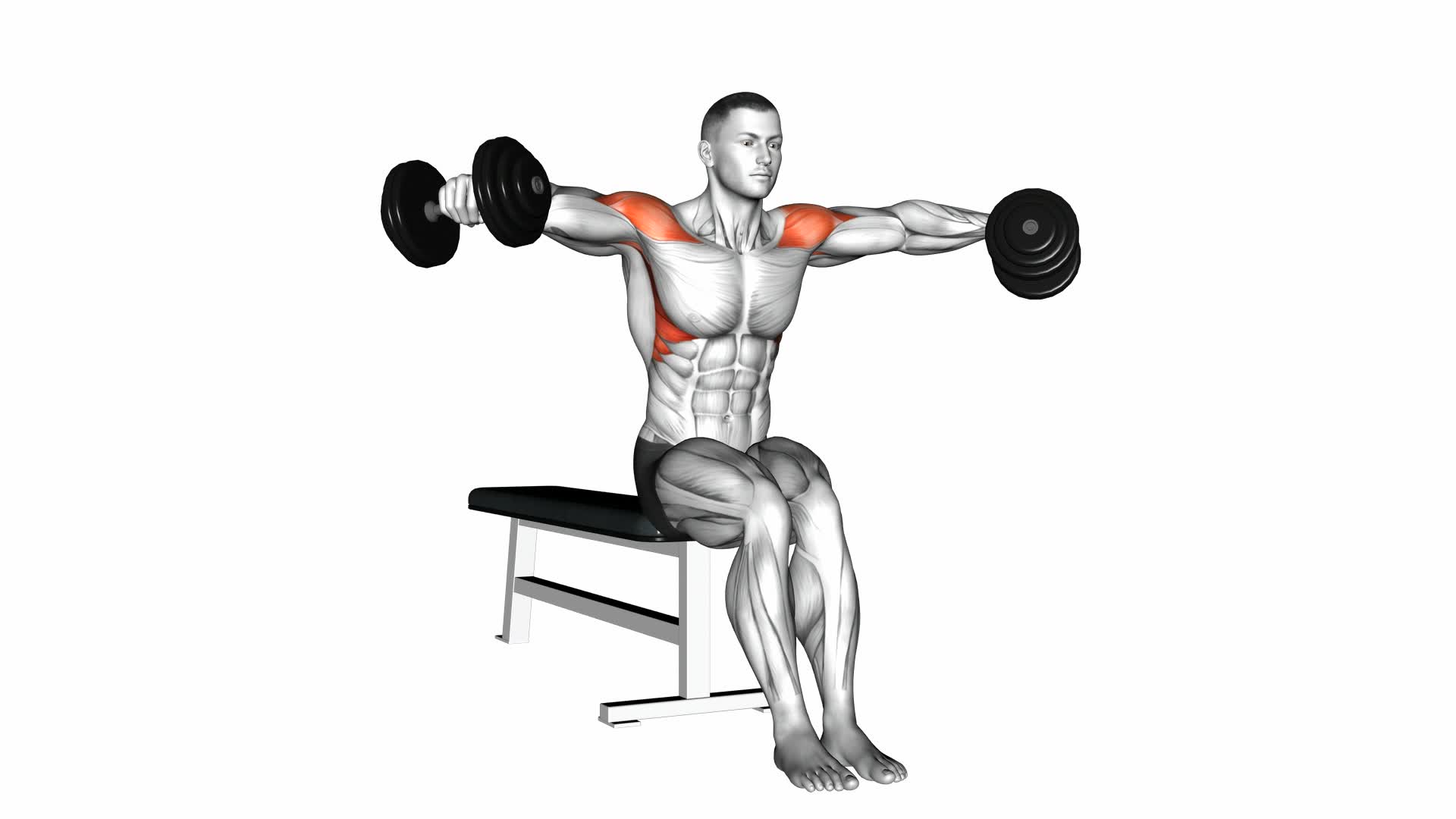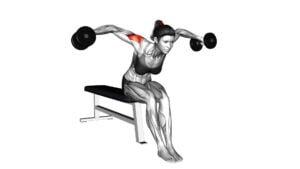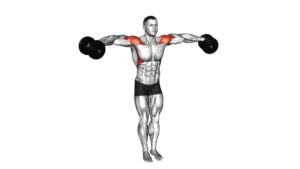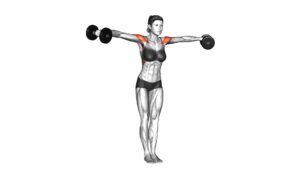Dumbbell Seated Bent Arm Lateral Raise – Video Exercise Guide & Tips

Looking to sculpt your shoulders and build upper body strength? The Dumbbell Seated Bent Arm Lateral Raise is the exercise for you. In this video exercise guide, we'll show you the proper form and technique to maximize your results.
Watch This Exercise Video
Whether you're a beginner or an advanced user, we've got variations and progression tips to challenge you. Avoid common mistakes and get the most out of this exercise with our helpful tips.
Get ready to elevate your workout routine with this effective shoulder exercise.
Key Takeaways
- Maintaining proper form and technique is crucial for engaging the lateral deltoids effectively.
- Choosing the right weight is important to challenge the lateral deltoids without compromising form.
- Controlling movement speed allows for maximum benefits and muscle activation.
- Keeping the arms at shoulder level targets the lateral deltoids and enhances shoulder development.
Benefits of the Dumbbell Seated Bent Arm Lateral Raise
Get stronger shoulders with the Dumbbell Seated Bent Arm Lateral Raise. This exercise offers numerous benefits for your shoulder muscles. First and foremost, it helps to strengthen and tone your deltoids, which are the main muscles responsible for shoulder movement. By regularly performing this exercise, you can enhance your shoulder stability and improve your overall posture.
Additionally, the Dumbbell Seated Bent Arm Lateral Raise targets your trapezius muscles, which are located in your upper back and play a crucial role in shoulder movement and stability. This exercise also engages your rotator cuff muscles, which are essential for shoulder joint stability and injury prevention. Moreover, by incorporating the Dumbbell Seated Bent Arm Lateral Raise into your workout routine, you can increase your upper body strength and enhance your overall athletic performance.
So, if you're looking to build stronger shoulders and improve your shoulder stability, this exercise is definitely worth including in your training regimen.
Now that you understand the benefits of the Dumbbell Seated Bent Arm Lateral Raise, let's dive into the proper form and technique for the exercise.
Proper Form and Technique for the Exercise
How can you perform the Dumbbell Seated Bent Arm Lateral Raise with proper form and technique? Follow these steps to ensure you're performing the exercise correctly:
- Sit on a bench with your feet flat on the floor and your back straight. Hold a dumbbell in each hand, palms facing inward and arms bent at a 90-degree angle.
- Keeping your elbows in line with your shoulders, exhale and slowly raise the dumbbells out to the sides until your upper arms are parallel to the floor. Keep your wrists straight and your core engaged.
- Inhale and lower the dumbbells back down to the starting position, maintaining control and avoiding any swinging or jerking motions.
By performing the Dumbbell Seated Bent Arm Lateral Raise with proper form and technique, you can reap the benefits of shoulder exercises. This exercise targets the medial deltoids, helping to strengthen and tone your shoulder muscles. It also improves shoulder stability and enhances overall upper body strength.
If you're looking for alternatives to the Dumbbell Seated Bent Arm Lateral Raise, you can try exercises such as lateral raises with resistance bands, cable lateral raises, or standing dumbbell lateral raises. These exercises provide similar benefits and can help you mix up your shoulder workout routine.
Variation and Progression for Advanced Users
To challenge yourself as an advanced user, increase the weight of the dumbbells used in the Dumbbell Seated Bent Arm Lateral Raise. By using heavier weights, you'll increase the resistance and stimulate more muscle fibers, leading to greater muscle activation and growth.
When selecting the weights, ensure that they're challenging but still manageable, allowing you to complete the exercise with proper form and technique.
Another advanced modification you can try is performing the exercise standing instead of seated. This variation adds an element of instability, engaging more muscles to maintain balance and control throughout the movement. It also increases the demand on your core muscles for stabilization.
To further progress the exercise, you can incorporate supersets or drop sets. Supersets involve performing the Dumbbell Seated Bent Arm Lateral Raise immediately followed by another exercise targeting the same muscle group, such as the Dumbbell Shoulder Press. This intensifies the workout and promotes muscle growth.
Drop sets involve performing multiple sets with progressively lighter weights, increasing the total volume of the exercise and challenging your muscles in a different way.
Remember to always listen to your body and gradually increase the intensity of your workouts. Push yourself, but also prioritize proper form and technique to prevent injuries.
Common Mistakes to Avoid During the Exercise
To avoid common mistakes during the Dumbbell Seated Bent Arm Lateral Raise, it's important that you maintain proper form and technique. Here are three common mistakes to avoid:
- Using too much weight: One of the most common mistakes people make is using weights that are too heavy. This can lead to poor form and increase the risk of injury. Start with a weight that allows you to perform the exercise with proper form and gradually increase the weight as you get stronger.
- Swinging the arms: Another common mistake is swinging the arms instead of using controlled movements. This not only reduces the effectiveness of the exercise but also puts strain on the shoulder joints. Keep your movements slow and controlled, focusing on isolating the shoulder muscles.
- Raising the arms too high: It's important to avoid raising the arms too high during this exercise. When the arms go above shoulder level, the focus shifts from the lateral deltoids to the traps and upper back muscles. Keep the arms at shoulder level to target the intended muscle group.
Tips for Maximizing Results With the Dumbbell Seated Bent Arm Lateral Raise
To maximize results with the Dumbbell Seated Bent Arm Lateral Raise, focus on proper form and engage your shoulder muscles by keeping your movements controlled and your arms at shoulder level. This exercise is excellent for maximizing shoulder development and specifically targets the lateral deltoids, the muscles responsible for shoulder width and definition.
First and foremost, it's crucial to maintain proper form throughout the exercise. Sit on a bench with your feet firmly planted on the ground and your back straight. Hold a dumbbell in each hand with your palms facing inward. As you raise your arms out to the sides, keep your elbows slightly bent and your wrists relaxed. It's essential to avoid swinging or using momentum to lift the dumbbells, as this can reduce the effectiveness of the exercise.
Next, focus on engaging your shoulder muscles. Imagine squeezing your shoulder blades together as you lift the dumbbells. This will help activate the lateral deltoids more effectively, leading to better results. Additionally, controlling the speed of your movements is crucial. Lower the dumbbells slowly and with control to fully engage the muscles and maximize the benefits of the exercise.
Lastly, keep your arms at shoulder level throughout the movement. Raising your arms too high can shift the focus away from the lateral deltoids and onto other muscle groups. By keeping your arms parallel to the ground, you ensure that the lateral deltoids are targeted properly, leading to greater shoulder development.
Frequently Asked Questions
How Many Sets and Reps Should I Do for the Dumbbell Seated Bent Arm Lateral Raise?
To get the most out of the dumbbell seated bent arm lateral raise, you need to focus on the number of sets and reps.
It's important to find the right balance for your fitness level and goals. Start with 2-3 sets of 8-12 reps, but don't be afraid to adjust as needed.
Remember to maintain proper form throughout the exercise to maximize its effectiveness and prevent injury.
Can I Perform This Exercise Without a Bench?
Yes, you can perform the dumbbell seated bent arm lateral raise without a bench. There are alternative exercises you can try, such as standing bent arm lateral raises or seated bent arm lateral raises using a stability ball.
When performing this exercise without a bench, make sure to maintain proper form by keeping your back straight, engaging your core, and focusing on the movement of your arms.
Is It Necessary to Warm up Before Doing the Dumbbell Seated Bent Arm Lateral Raise?
Before performing the dumbbell seated bent arm lateral raise, it's necessary to warm up. Warming up before exercise has several benefits, such as increasing blood flow to the muscles and preparing them for the upcoming movements.
Additionally, variations of this exercise can be performed to target different areas of the shoulders and arms.
It's important to remember to start with lighter weights and gradually increase the intensity as you become more comfortable and confident in the movement.
Can I Use Resistance Bands Instead of Dumbbells for This Exercise?
Yes, you can definitely use resistance bands instead of dumbbells for the seated bent arm lateral raise. Using resistance bands offers several benefits for this exercise.
They provide constant tension throughout the movement, which can help target and strengthen the muscles more effectively.
Additionally, resistance bands are portable and versatile, allowing you to easily adjust the resistance level.
What Muscles Does the Dumbbell Seated Bent Arm Lateral Raise Primarily Target?
The dumbbell seated bent arm lateral raise primarily targets your shoulder muscles. This exercise specifically works your deltoids, which are the main muscles responsible for lifting your arms to the side. By using dumbbells and maintaining a seated position, you can effectively isolate and strengthen these muscles.
It's important to focus on proper form and control throughout the movement to maximize the benefits and prevent injury.
Conclusion
The dumbbell seated bent arm lateral raise is a beneficial exercise for targeting the shoulders and upper back.
By maintaining proper form and technique, you can maximize the effectiveness of this exercise.
Advanced users can also try variations and progressions to challenge their muscles further.
Avoiding common mistakes and following tips for maximizing results will help you see improvements in strength and muscle definition.
Give this exercise a try and reap the benefits for your upper body.

Author
Years ago, the spark of my life’s passion ignited in my mind the moment I stepped into the local gym for the first time. The inaugural bead of perspiration, the initial endeavor, the very first surge of endorphins, and a sense of pride that washed over me post-workout marked the beginning of my deep-seated interest in strength sports, fitness, and sports nutrition. This very curiosity blossomed rapidly into a profound fascination, propelling me to earn a Master’s degree in Physical Education from the Academy of Physical Education in Krakow, followed by a Sports Manager diploma from the Jagiellonian University. My journey of growth led me to gain more specialized qualifications, such as being a certified personal trainer with a focus on sports dietetics, a lifeguard, and an instructor for wellness and corrective gymnastics. Theoretical knowledge paired seamlessly with practical experience, reinforcing my belief that the transformation of individuals under my guidance was also a reflection of my personal growth. This belief holds true even today. Each day, I strive to push the boundaries and explore new realms. These realms gently elevate me to greater heights. The unique combination of passion for my field and the continuous quest for growth fuels my drive to break new ground.







